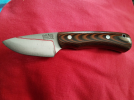Even on very small blades, grinding a VERY WIDE, flat bevel will take a long time, likely HOURS at least, if done by hand - and even slower, with the smallish stones used in guided systems. Especially when removing steel to a significant depth. Grinding time increases exponentially with the surface area being ground, due in part to the fact that grinding pressure will be distributed over a wider area and therefore reduced, the deeper you grind into that broad convex and the wider the contact area becomes as a result.
I'd suggest instead, just gradually thin the convex over time, each time you sharpen the blade. Don't worry so much about trying to make it flat. Making it thinner behind the edge will bring the greatest cutting benefit, and retaining the convexed 'shoulders' behind the cutting edge will also making cutting that much slicker. And that could be done over some time, just laying the blade flush to a sheet of wet/dry SiC sandpaper (start with something like ~ 150 - 220 grit) over a firm backing. Something like stone, glass or very hard wood, with a couple or three sheets of plain paper underneath the sandpaper, will allow the sandpaper to conform to the blade grind and keep the grinding scratches more uniform and neat, but still be firm enough to be aggressive and thin it out. A little finger pressure directly against the shoulders of the convex behind the edge will focus pressure in the area where the most work needs to be done to thin it.





